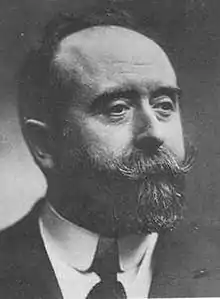Jaime Chicharro Sánchez-Guió | |
|---|---|
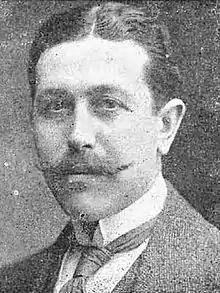 | |
| Born | Jaime Chicharro Sánchez-Guió 1889 Torralba de Calatrava, Spain |
| Died | 1934 (aged 44–45) Guadarrama, Spain |
| Nationality | Spanish |
| Occupation(s) | lawyer, landowner |
| Known for | Politician |
| Political party | |
| Spouse | Dolores Lamamié de Clairac Romero y Bermúdez de Castro (1890-1974) |
| Children | 13 |
Jaime Chicharro Sánchez-Guió (1889–1934) was a Spanish Conservative and Carlist politician. He is known mostly as the moving spirit behind turning a fishing bay in Burriana into a modern port, facilitating export of oranges grown in the area. As a politician he is recognized as representative of large proprietors within the Carlist movement.
Family and youth
Jaime Chicharro Sánchez-Guió was born to a family of Castilian landowners. His paternal ancestors originated from Vascongadas; his grandfather, Jesús Chicharro de la Torre, was a military engineer and settled in the province of Ciudad Real following railway construction works.[1] Jaime's father, José Chicharro Martín del Moral (1856-1905),[2] sided with the legitimists during the Third Carlist War.[3] He married Soledad Sánchez-Guió Ruiz-Hidalgo (1860-1912).[4] The couple had 4 children, apart from Jaime also three daughters,[5] all raised in a fervently Catholic ambience.
In 1897 the young Jaime entered the Jesuit Colegio Nuestra Señora del Recuerdo in the Madrid district of Chamartín de la Rosa.[6] Having completed secondary education he moved to Biscay commencing law studies in the Jesuit Deusto College.[7] Following graduation he completed his education obtaining diploma in Philosophy and Letters from the Universidad Central (later Universidad Complutense) in Madrid.[8] Holding two diplomas he settled in Madrid and assumed the chair of History in same Jesuit college he had attended earlier.[9]
In 1912 Chicharro married Dolores Lamamié de Clairac Romero y Bermúdez de Castro (1890-1974),[10] related to the Salamanca landowner and later a well-known Carlist politician, José María Lamamié de Clairac y de la Colina.[11] As she inherited some 300 hectares[12] around Villarreal and Nules, the family moved to the spouse's La Salmantina estate, now located in the municipality of Les Alqueries (Castellón province).[13] The couple had 13 children,[14] born between 1914 and 1932. During early months of the Civil War the oldest daughter was tortured and killed by the Republican militia in Madrid.[15] Five sons volunteered to the Carlist Requeté;[16] one of them died in 1939 due to tortures suffered as the Republican POW.[17] Four sons joined División Azul; two of them died in combat in Russia, the two who survived grew to Francoist generals.[18] His second youngest son served as a diplomat and subgobernador in the Spanish Equatorial Guinea.[19] The youngest son became sort of celebrity as a wrestling champion in the 1950s.[20] Some of Jaime's grandchildren became public figures and stirred political controversy as late as in 2013.[21]
Young Carlist
Chicharro inherited his militant ultraconservative outlook after his father, who following the Carlist war service contributed belligerent pieces to the Carlist Ciudad Real based El Manchego weekly in the 1880s.[22] The leaning was further reinforced when during his Madrid academic years Chicharro met and got fascinated by Juan Vázquez de Mella, the top Carlist theorist.[23] In 1909 he co-founded the local Centro Tradicionalista[24] and together with other young Carlists he set up El Combate,[25] a review later renamed to Juventud Tradicionalista.[26] Active in Catholic organizations, he started to appear on public meetings, like those confronting the idea of secular education.[27] In 1911 he engaged in launching Congreso Eucaristico and later joined Junta Nacional de Propagandistas de Acción Católica.[28] Also in 1911 Chicharro joined the Madrid Junta Católica, part of a national electoral effort engineered by the Church and intended to produce a grand Catholic political alliance.[29] At that time he was already a Carlist activist recognized nationally.[30]
When following his marriage Chicharro moved to Castellón province he remained in the same political ambience, becoming president of the local Juventud Jaimista[31] and in 1915 growing to jefe of the Villareal Jaimistas.[32] In 1916 he entered the Castellón Junta Provincial and became its vice-president, going on with his Villarreal jefatura duties.[33] The same year for the first time he launched his bid for the Cortes standing in the Nules district. At that time Valencian Carlism was divided between the mainstream purs and the dissident paquistes,[34] followers of Francisco Giner Lila;[35] Chicharro seemed to have allied with none and unsuccessfully ran a broad conservative ticket, forming part of the contenders loyal to the Murcian party leader, Juan de la Cierva y Peñafiel.[36]
He tried his luck again in Nules in the subsequent campaign of 1918, though political configuration of the time seems particularly obscure and illegible. According to some, he represented the purs faction and was supported by a partially controlled newspaper, La Gaceta de Levante,[37] opposed by the competing paquistes fraction and the conservative mauristas.[38] According to another scholar, Chicharro was criticized by orthodox Carlists for his strong predilection for broad Right-wing alliances, blurring the Traditionalist political identity.[39] He lost again, failing to get the ticket also in by-elections staged later that year as the victorious candidate died soon after having been elected.[40]
Mellista

In the 1910s Carlism was increasingly divided between its top theorist Juan Vazquez de Mella and the claimant, Jaime III; the former tended to downplay dynastical issues for the sake of advancing a grand Right-wing formation, united by Traditionalist values. Chicharro sympathised with his former Madrid master and emerged as one of the most vehement Mella supporters;[41] when in 1919 the crisis exploded and the Carlists were forced to take sides, he left the claimant and joined the rebels.[42] In the 1919 electoral campaign he already represented a broad and somewhat vague conservative platform, advocating a broad Catholic national party of the Right.[43] Some sources claim he counted among governmental maurista candidates,[44] some present him as a catholic-monarchist, a ciervista[45] or a Carlist.[46] Finally successful,[47] when in the Cortes he sided with the ciervistas.[48] In 1920 re-election campaign Chicharro had the loyal Carlists pitted against him,[49] but he managed to renew his ticket[50] and served in the diet until 1923.[51]
In the parliament, at that time dominated by the Conservatives of Eduardo Dato, Chicharro remained a rather restless and turbulent deputy, occasionally sliding to opposition. Apart from the customary anti-liberal diatribes, he was particularly vocal on financial issues, entering into taxation and budgetary disputes with the Minister of Economy.[52] His most lasting achievement is a Royal Order, which marked significant state resources for development of the local Burriana harbor.[53] The design, apart from massive upgrade of the facilities, envisaged also major investments which connected the port with the national railroad network.[54] The work was carried out until the early 1930s and transformed what used to be chiefly a simple fishing bay[55] into a small but modern commercial transport hub.[56] Key beneficiaries of the project were the local Levantine landowners, who gained a gateway for the export of their orange production;[57] Chicharro kept lobbying for their cause in Madrid also during the decades to come.[58] In recognition of his merits, the city of Burriana named Chicharro its hijo adoptivo;[59] upon his return from Madrid he was greeted with arches of triumph and venerating celebrations.[60]
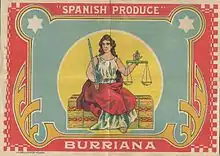
Though initially one of the most outspoken de Mella supporters, Chicharro did not integrate fully in the Mellista group; some speak even of "chicharrismo",[61] others dubbed him "mauro-ciervista".[62] While de Mella was firm on his Traditionalist principles and opted for a grand conservative party built upon them, Chicharro started to lean towards the vision of Victor Pradera, embracing a more loose Right-wing alliance held together by a lowest common denominator.[63] In the early 1920s he effectively left the Mellistas; some scholars consider him paradigmatic for many rebellious Carlists who joined de Mella in 1919, but soon abandoned him to pursue their own goals and to amalgamate in other Right-wing groupings.[64]
Catholic conservative
During electoral campaign of 1923 Chicharro was considered a favourite.[65] It is not clear to what extent he ruined his chances himself: during one of electoral meetings in the very city of Burriana he was challenged by a local workers' leader. Chicharro resolved to a stick and engaged in a brawl, resulting in his victim treated in hospital for head wounds and an administrative action taken against the assailant.[66] Diario de Castellón, the newspaper he founded and owned, failed to mobilize enough support and produced merely significant financial losses.[67] Eventually Chicharro and an albista counter-candidate recorded almost the same score; the latter was declared victorious following behind-the-scene dealings.[68]
In 1924 Chicharro was active setting up the local Castellon branch of Union Patriotica[69] and soon became its provincial jefe.[70] In the new partido unico he championed the Catholic-based branch and got increasingly alienated by what he perceived as marginalization of the Catholic groupings; other local upetistas accused him of building the local structures chiefly around his former Traditionalist supporters.[71] The conflict climaxed in 1925, when Chicharro in protest resigned from the provincial presidency.[72]
In 1925 the Chicharros left Levante and moved to Madrid; it is not clear whether the change was anyhow related to political tension or was rather due to financial issues, as reported by some sources;[73] In the capital he started to practice as a lawyer[74] and apparently became fairly successful, as in the early 1930s he grew to member of Junta de Gobierno of the Madrid Congregacion de los Abogados.[75]
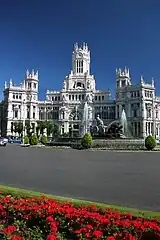
In 1927 Chicharro commenced his career as municipal official, appointed one of 64 new councilors of the Madrid ayuntamiento.[76] In 1928 he grew to teniente de alcalde[77] responsible for the Chamberí district; appointed member of Junta municipal de Primera enseñanza he specialized in education issues,[78] dealing also with culture[79] and science.[80] Chicharro resumed contacts with Vázquez de Mella;[81] only weeks after his death, in March 1928, he arranged for a commemorative plaque to be mounted on the Escuela Normal de Maestros wall[82] and looked after his library.[83] In 1930 the press already referred to him as former teniente de alcalde, but it is not clear when he ceased.[84]
During the last years of the monarchy Chicharro seemed politically disoriented. Though in the press plebiscite he was voted one of three best possible representatives of Castellon province in Asamblea Nacional,[85] he was not appointed its member. He remained active in Catholic groupings like Acción social, giving lectures and contributing as organizer and manager. As friend of Lamamié he maintained links with his Acción Castellana, set up in 1930, and was drawn closer to another of his organizations, Federación Católico-Agraria Salmantina.[86] He remained in the circle of Francesc Cambó, leader of the Catalan conservative Lliga Regionalista.[87] Last but not least, he retained his Carlist contacts with the former mellistas,[88] now headed by the new leader, Victor Pradera.
Reconciled Carlist

During the local elections of April 1931 Chicharro was overwhelmed by the republican tide and as an independent conservative candidate[89] he failed to get voted into the Madrid ayuntamiento.[90] After proclamation of the Republic he decided to take part in the June 1931 elections to the Cortes from Castellón, still supported by Diario de Castellón, officially the voice of Federación Castellonense de Sindicatos Agrícolas.[91] Chicharro was invited to join the Republicans; according to one source he boldly refused,[92] but according to the press he was running as "derecha republicana".[93] The result was rather poor – some call it humiliating[94] - since he arrived 11th with some 11 thousand votes out of 96,000 cast in the province.[95]
In late 1931 Chicharro started to attend Traditionalist meetings,[96] gradually re-joining followers of the Carlist king and entering their new organization, Comunión Tradicionalista. Though not counting among national leaders, in the press he emerged as one of the most-quoted Carlist speakers of the first half of 1932, extremely active touring the country and delivering public addresses. In January 1932 he already gave lecture about collaboration and Carlism;[97] in February he presented a broad foreign policy program including control of Gibraltar,[98] federation with Portugal and confederation with Latin American states,[99] in March he labeled the proposed universal suffrage as unjust and lambasted the Republican government for overspending and highly inflated budget.[100] The same month he triggered riots in Soria by proclaiming that he had no intention of surrendering an iota of his wealth without a fight.[101] In April he got his car stolen from the Madrid street.[102] A number of meetings with him taking part were suspended when already ongoing for fear of unrest.[103] Late 1932 he started to write first-page newspaper pieces himself.[104]

In 1932 Chicharro got engaged in conspiracy of José Sanjurjo, though no details are known.[105] Following the disastrously failed coup he was identified as one of the culprits[106] and became subject of the expropriation, designed to boost the floundering Agrarian Reform.[107] Later that year two of his sons were detained and administrated exile in the Spanish Sahara outpost of Villa Cisneros, which would soon turn into the Carlist hotbed.[108] Continuing with his tours across the country[109] later in 1933 he defended some of the Sanjuriada conspirators in court,[110] though he was himself closely watched by the security[111] and in May he faced trial for inflammatory speak.[112]
Last months

In 1933 Chicharro was active mixing with the Alfonsist monarchists in the Tradicionalistas y Renovación Española alliance; by the local Castellon Liaison Committee he was agreed to represent it in the forthcoming elections.[113] This gained him hostility among new radical Carlist activists like Jaime del Burgo, who despised fraternization with caciques and debris of the Alfonsine monarchy. Moreover, for the Carlist youth the landowners like Lamamié and Chicharro became marked men as privileged section of politically dominant potentates, who are "obstructing the Agrarian Reform by the feudal egoism of the odious grandees of grain".[114] Though indeed within Carlism Chicharro formed the most reactionary faction, conservatism did not render him averse to new radical social movements.[115] Discussing Benito Mussolini and Adolf Hitler he declared that Traditionalism, "though not one and the same thing, is very sympathetic towards them, as they are waging war against Judaism, freemasonry and Marxism, building an organized corporative state. What is inacceptable to us is the state's overwhelming sovereignty and dominance. For us the family comes first, followed by municipality, region and state, which is the last element in this chain".[116]
Riding the wave of soaring rightist sympathies, in 1933 Chicharro was elected to the Madrid ayuntamiento from the Chamberí district.[117] However, running on the Carlist ticket to the Cortes from Castellón he narrowly lost,[118] though initially he was reported by the press as victorious[119] and his fellow Traditionalist Juan Granell Pascual was indeed elected.[120] At that time he was already seriously ill.[121] Having been generally of rather poor health, as a chain-smoker Chicharro developed grave respiratory problems.[122] Though as late as 1932 he was still hailed by the press as "ilustrado joven",[123] in August 1933 he was placed in the tuberculosis-treatment Real Sanatorio de Guadarrama,[124] where he died early 1934.[125] His funeral and related commemorative homage feasts staged across Spain helped to mobilize support and demonstrated growing dynamics of Carlism.[126] As the widow and 13 half-orphaned children were in financial dire straits, Comunión Tradicionalista launched a public fund-raising campaign intended to assist them.[127]
See also
Footnotes
- ↑ Biografia sucinta de D. Jaime Chicharro, [in:] Buris-Ana. Boletín de la Agrupación Burrianense de Cultura 77 (1958), p. 2
- ↑ José Chicharro Martín del Moral entry at Geneanet genealogical service, available here
- ↑ Nota biográfica sobre Jaime Chicharro y Sánchez-Guio (1889-1934), [in:] CED Borriana, 08.03.2014, available here; the same source claims, probably after Biografia sucinta de D. Jaime Chicharro, that he reached the rank of a general, though it is not clear how and when he could have reached this honor
- ↑ Soledad Sánchez-Guio Ruiz-Hidalgo entry at Geneanet genealogical service, available here
- ↑ Biografia sucinta de D. Jaime Chicharro, p. 2; some sources indicate 2 sisters, see Geneanet service available here
- ↑ ABC 14.01.34 available here, Biografia sucinta de D. Jaime Chicharro
- ↑ Guillem Rios, Un paseo por el cemeterio (parte I), [in:] elperiodic.com 01.11.07, available here Archived 2011-06-18 at the Wayback Machine, Biografia sucinta de D. Jaime Chicharro, p. 2
- ↑ ABC 14.01.34, Biografia sucinta de D. Jaime Chicharro, p. 2
- ↑ Nota biográfica sobre Jaime Chicharro y Sánchez-Guio (1889-1934)
- ↑ Dolores Lamamie de Clairac Romero entry at Geni genealogical service, available here
- ↑ Dolores was the daughter of Lamamie's paternal cousin
- ↑ Biografia sucinta de D. Jaime Chicharro, p. 2
- ↑ Nota biográfica sobre Jaime Chicharro y Sánchez-Guio (1889-1934), Biografia sucinta de D. Jaime Chicharro, p. 2
- ↑ CHICHARRO LAMAMIÉ DE CLAIRAC, Antonio thread at Memoriablau service, available here Archived 2014-02-19 at the Wayback Machine
- ↑ in 1936 or 1937, dates given differ; Hércules Cortez, [in:] Club de Boxeo Paulino Uzcudun service 03.11.11, available here
- ↑ Hércules Cortez, [in:] Club de Boxeo Paulino Uzcudun service 03.11.11
- ↑ CHICHARRO LAMAMIÉ DE CLAIRAC, Antonio thread at Memoriablau service; other version is that he suffered fatal cardial breakdown having the learnt the fate of his sister Maria Dolores, see Nota biográfica sobre Jaime Chicharro y Sánchez-Guio (1889-1934)
- ↑ Juan Chicharro Ortega, La división española de voluntarios en Rusia, [in:] ABC 17.07.10, available herel
- ↑ Rios 2008
- ↑ Hércules Cortez, [in:] Club de Boxeo Paulino Uzcudun service 03.11.11, Hércules Cortez: el mejor wrestler español de la historia, [in:] Se-Puto-Acabó service available here
- ↑ see El Pais 27.02.13, available here and alertadigital service 27.02.13, available here
- ↑ he contributed under the pen-name "K. Tite" and his article prompted penalty action against the review, see José Narvaez Fernández "El Manchego" (1886-1888). La prensa carlista a traves de un periodico regional, [in:] Cuadernos de estudios manchegos 8 (1978), p. 101
- ↑ Emotivo homenaje a D. Jaime Chicharro en su pueblo natal, Torralba de Calatrava, [in:] Buris-Ana 145 (1976), p. 2
- ↑ Biografia sucinta de D. Jaime Chicharro, p. 2
- ↑ Emotivo homenaje a D. Jaime Chicharro en su pueblo natal, Torralba de Calatrava, [in:] Buris-Ana 145 (1976), p. 2
- ↑ Nota biográfica sobre Jaime Chicharro y Sánchez-Guio (1889-1934)
- ↑ El Siglo Futuro 19.04.10, available here
- ↑ Nota biográfica sobre Jaime Chicharro y Sánchez-Guio (1889-1934); the organization is also referred to as Asociación católioo-nacional de jóvenes propagandistas, see El Siglo Futuro 09.06.10, available here
- ↑ El Siglo Futuro 07.01.11, available here
- ↑ the newly created Juventud Carlista in Plasencia, a town in Northern Extremadura, asked Chicharro to be – along the likes of Esteban Bilbao or Rafael Pérez Aguago – its honorary president, Rodolfo Orantos Martín, El desconocido carlismo placentino. Represión, Exilio y Memoria Histórica, [in:] Memoria histórica de Plasencia y las comarcas, Plasencia 2014, ISBN 9788469708583, p. 99
- ↑ in 1914 he was already reported as former president, El Liberal 14.10.14, available here
- ↑ reported as hosting Cerralbo during his tours across the country, El Liberal 14.10.14, also La Correspondencia de España 01.11.15, available here
- ↑ Gerard Llansola, Estructura organizativa i participació electoral del carlisme castellonenc en la decadéncia de la Restauració (1914-1918), [in:] Rosa Monlleó Peris, Castelló al segle XX, Valencia 2006, ISBN 848021564X, 9788480215640, p. 212
- ↑ Llansola 2006, p. 221
- ↑ Nota biográfica sobre Jaime Chicharro y Sánchez-Guio (1889-1934)
- ↑ Nota biográfica sobre Jaime Chicharro y Sánchez-Guio (1889-1934); overview of electoral results in Castellon in 1913-1916 in Gerard Llansola Gil, Republicanisme, identitat popular i hegemonia municipal: Castelló de la Plana, 1913-1917, Castellon 2006, ISBN 8480215690, 9788480215695, p. 89
- ↑ Llansola 2006, p. 228, also El Sol 06.02.18, available here
- ↑ Llansola 2006, p. 228
- ↑ Juan Ramón de Andrés Martín, El cisma mellista. Historia de una ambición política, Madrid 2000, ISBN 9788487863820, p. 134
- ↑ Nota biográfica sobre Jaime Chicharro y Sánchez-Guio (1889-1934), Llansola 2006, p. 228; many picturesque details available here
- ↑ along Pradera, Garcia Guijarro, Careaga, Iglesias and conde Doña Marina, Andrés Martín 2000, pp. 146-7
- ↑ Andrés Martín 2000, p. 146
- ↑ La Epoca 11.08.19, available here
- ↑ Andrés Martín 2000, p. 171, this version confirmed also in El Sol 03.06.19, available here
- ↑ La Epoca 24.05.19, available here
- ↑ La Correspondencia de España 25.05.19, available here
- ↑ see the official Cortes service available here
- ↑ Andrés Martín 2000, p. 175
- ↑ ABC 17.11.20, available here
- ↑ as a ciervista, see La Acción 10.11.20, available here
- ↑ see the official Cortes service, available here
- ↑ La Correspondencia de España 19.03.20, available here
- ↑ Nota biográfica sobre Jaime Chicharro y Sánchez-Guio (1889-1934), Rios 2008
- ↑ La familia Chicharro dona a Burriana un plano del proyecto del ferrocarril de la Vilavella al Puerto [in:] buriana.es service 02.03.11, available here
- ↑ compare Naranjas: cuando no existía el puerto en Burriana [in:] wikisenior service, available here
- ↑ Nota biográfica sobre Jaime Chicharro y Sánchez-Guio (1889-1934), Rios 2008
- ↑ Chicharro was himself member of the local Circulo Frutero and Agrupación de Exportadores, María Dolores Agustí, Juan Bautista Soler y Martí, representante del comercio naranjero en Burriana (1879-1936), [in:] Rosa Monlleó Peris [ed.], Castello Al Segle XX, Castellon 2006, ISBN 9788480215640, p. 248. The traditional Valencian agricultural specialty was silk, but silk blight and growing competition pushed Valencian silk out of many markets in mid-19th century. Following unsuccessful reformatting to vineyards, it was the oranges, until late 18th century considered decorative plants, which became iconic Valencian products. As living standards rose and transport network improved, Valencian oranges became a commercial success with exports especially to Britain, France and Germany, see Julia Hudson-Richards, The Orange Proletariat: Social Relations in the Pais Valenciano, 1860--1939 [PhD thesis University of Arizona], Phoenix 2008, ISBN 054968333X, 9780549683339, pp. 22-25
- ↑ he was reported as active in 1928, see El Imparcial 21.07.28, available here and in 1931, see Heraldo de Madrid 22.01.31, available here
- ↑ Rios 2008
- ↑ Biografia sucinta de D. Jaime Chicharro, p. 2
- ↑ Andrés Martín 2000, p. 162
- ↑ Andrés Martín 2000, pp. 200-1
- ↑ which was also reflected by the fact that in the Cortes he sided with the ciervistas, not the mauristas, Andrés Martín 2000, p. 182
- ↑ Andrés Martín 2000, p. 201
- ↑ La Acción 26.03.23, available here
- ↑ La Epoca 07.02.23, available here, Heraldo de Madrid 07.02.23, available here, El Sol 07.02.23, available here
- ↑ Biografia sucinta de D. Jaime Chicharro, p. 2
- ↑ Biografia sucinta de D. Jaime Chicharro, p. 2
- ↑ Raul González Devís, Católico y autoritarios: la dictadura de Primo de Rivera en las comarcas castellonenses, [in:] Carlos Navajas Zubeldía, Diego Iturriaga Barco (eds.), Novísima: II Congreso Internacional de Historia de Nuestro Tiempo, Logroño 2010, ISBN 9788469365571, p. 239
- ↑ González Devís 2010, p. 241
- ↑ Chicharro was attacked by "elementos de derecha", which proves that it was possible to be more Right-wing than himself, González Devís 2010, p. 241
- ↑ González Devís 2010, p. 241 (see also the footnote). In Burriana Chicharro left his followers, led by Juan Bautista Soler Martí
- ↑ Biografia sucinta de D. Jaime Chicharro, p. 2; nothing is known about the fate of Chicharro's landholdings, though he must have felt financial pressure by rapid growth of his family, children born almost every year
- ↑ ABC 12.07.28, available here
- ↑ ABC 12.02.33, available here
- ↑ La Voz 16.12.27, available here, ABC 20.12.27, available here
- ↑ La Construccion Moderna 15.07.28, available here
- ↑ La Voz 23.12.27, available here
- ↑ organising Juegos Florales, El Siglo Futuro 08.03.27, available here
- ↑ he supported pre-historical studies, Anuario de prehistoria madrileña 1930, available here
- ↑ de Mella greeted Chicharro with his own photo signed "A mi entrañable amigo el heroico Chicharro", La Correspondencia militar 29.11.29, available here, see also ABC 20.12.27, available here
- ↑ ABC 25.03.27, available here
- ↑ El Sol 22.11.29, available here
- ↑ La Voz 26.03.30, available here
- ↑ La Correspondencia de España 17.09.27, available here
- ↑ ABC 26.01.27, available here
- ↑ ABC 17.02.31, available here
- ↑ Nota biográfica sobre Jaime Chicharro y Sánchez-Guio (1889-1934), Rios 2008
- ↑ La Voz 06.04.31, available here
- ↑ Heraldo de Madrid 13.04.31, available here
- ↑ the newspaper retained an ultraconservative line, usually classified as a rightist or forming part of catolicismo agrario, see González Devís 2010, p. 241, Cronicas de Castellon service, available here Archived 2016-03-04 at the Wayback Machine
- ↑ quoted saying "si veinte años hubiera República en España, veinte años y un dia sería monárquico por tradición e ideales", referred after Biografia sucinta de D. Jaime Chicharro, p. 2
- ↑ La Voz 29.06.31, available here,
- ↑ Martin Blinkhorn, Carlism and Crisis in Spain 1931-1939, Cambridge 1975, ISBN 9780521207294, pp. 123, 333
- ↑ La Voz 29.06.31, ABC 04.07.31, available here
- ↑ El Siglo Futuro 28.11.31, available here
- ↑ El Siglo Futuro 15.01.32, available here
- ↑ La Voz de las Patatas 24.04.16 available here
- ↑ El Siglo Futuro 16.02.32, available here
- ↑ El Siglo Futuro 30.03.32, available here
- ↑ Blinkhorn 1975, p. 80
- ↑ La Correspondencia 10.04.32, available here
- ↑ ABC 14.01.34, available here, El Sol 28.06.32, available here
- ↑ El Siglo Futuro 30.10.32, available here, El Siglo Futuro 09.11.32, available here
- ↑ Nota biográfica sobre Jaime Chicharro y Sánchez-Guio (1889-1934)
- ↑ El Siglo Futuro 17.06.32, available here
- ↑ Blinkhorn 1975, p. 92; it might not be unrelated that some sources claim he died „almost in poverty", Emotivo homenaje a D. Jaime Chicharro en su pueblo natal, Torralba de Calatrava
- ↑ Blinkhorn 1975, p. 96
- ↑ see e.g. El Siglo Futuro 10.04.33, available here, El Siglo Futuro 17.04.33, available here
- ↑ Heraldo de Madrid 04.05.33, available here
- ↑ Heraldo de Madrid 01.03.33, available here
- ↑ El Siglo Futuro 25.05.33, available here
- ↑ ABC 28.10.33, available here, El Siglo Futuro 13.11.33, available here
- ↑ Blinkhorn 1975, p. 172
- ↑ Blinkhorn 1975, p. 113
- ↑ ABC 14.03.33, available here
- ↑ Nota biográfica sobre Jaime Chicharro y Sánchez-Guio (1889-1934)
- ↑ Ramon Puig, El Bienni Reformador a les comarques septentrionals de Castelló (1931-1933), [in:] Rosa Monlleó Peris [ed.], Castello Al Segle XX, Castellon 2006, ISBN 9788480215640, p. 378, El Sol 05.12.33, available here
- ↑ El Siglo Futuro 22.11.33, available here
- ↑ Nota biográfica sobre Jaime Chicharro y Sánchez-Guio (1889-1934)
- ↑ Agustí 2006, p. 249
- ↑ La familia Chicharro dona a Buuriana [sic!] una librería que perteneció al artífice de la construcción del Puerto, [in:] Diario digital de Castellon 01.11.13, available here
- ↑ El Siglo Futuro 16.02.32, available here
- ↑ El Siglo Futuro 22.08.33, available here
- ↑ Rios 2008
- ↑ El Siglo Futuro 13.01.34, available here, El Siglo Futuro 23.01.34, available here, El Siglo Futuro 05.03.34, available here; the widow received a letter from the Carlist king Alfonso Carlos, El Siglo Futuro 25.01.34, available here
- ↑ El Siglo Futuro 01.03.34, available here
Further reading
- Juan Ramón de Andrés Martín, El cisma mellista. Historia de una ambición política, Madrid 2000, ISBN 9788487863820
- Biografia sucinta de D. Jaime Chicharro, [in:] Buris-Ana. Boletín de la Agrupación Burrianense de Cultura 77 (1958), pp. 2, 13
- Martin Blinkhorn, Carlism and Crisis in Spain 1931-1939, Cambridge 1975, ISBN 9780521207294
- Pascual Fandos Mingarro, Biografía de Jaime Chicharro, Madrid 1961
- Raul González Devís, Católico y autoritarios: la dictadura de Primo de Rivera en las comarcas castellonenses, [in:] Carlos Navajas Zubeldía, Diego Iturriaga Barco (eds.), Novísima: II Congreso Internacional de Historia de Nuestro Tiempo, Logroño 2010, ISBN 9788469365571, pp. 235–244
- Gerard Llansola, Estructura organizativa i participació electoral del carlisme castellonenc en la decadéncia de la Restauració (1914-1918), [in:] Rosa Monlleó Peris [ed.], Castello Al Segle XX, Castellon 2006, ISBN 9788480215640, pp. 207–236
External links
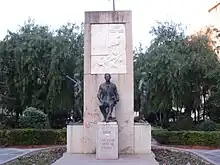
- Chicharro at CED Burriana website
- Historical Index of Deputies
- Chicharro's offspring discussed at a Francoist forum Archived 2014-02-19 at the Wayback Machine
- a passage at the Castellon cemetery
- homage to Chicharro by Torralba de Calatrava
- Chicharro family at geneanet
- history of the Burriana harbor
- homage Buris-Ana issue
- old Burriana on video
- Chicharro's youngest son in commercial movie
- La patria vale más que la democracia by Chicharro's grandson
- contemporary Carlist propaganda video


